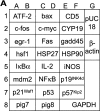Selective activation of the c-Jun NH2-terminal protein kinase signaling pathway by stimulatory KIR in the absence of KARAP/DAP12 in CD4+ T cells
- PMID: 12591902
- PMCID: PMC2193867
- DOI: 10.1084/jem.20020383
Selective activation of the c-Jun NH2-terminal protein kinase signaling pathway by stimulatory KIR in the absence of KARAP/DAP12 in CD4+ T cells
Abstract
Activation of CD4(+) T cells is governed by interplay between stimulatory and inhibitory receptors; predominance of stimulatory signals favors autoimmune reactions. In patients with rheumatoid arthritis, expression of the critical costimulatory molecule, CD28, is frequently lost. Instead, CD4(+)CD28(null) T cells express killer immunoglobulin-like receptors (KIRs) with a preferential expression of the stimulatory receptor, CD158j. The frequency of CD4(+)CD28(null) T cells in rheumatoid arthritis (RA) correlates with the risk for more severe disease. Moreover, the KIR2DS2 gene, which encodes for CD158j, is a genetic risk factor for rheumatoid vasculitis. CD158j signals through the adaptor molecule, KARAP/DAP12, to positively regulate cytotoxic activity in NK cells. However, the majority of CD4(+)CD28(null) T cell clones lacked the expression of KARAP/DAP12. Despite the absence of KARAP/DAP12, CD158j was functional and augmented interferon-gamma production after T cell receptor stimulation. Cross-linking of CD158j resulted in selective phosphorylation of c-Jun NH(2)-terminal protein kinase (JNK) and its upstream kinase, MKK4 that led to the expression of ATF-2 and c-Jun, all in the absence of extracellular signal-regulated kinase (ERK)1/2 phosphorylation. Mutation of the lysine residue within the transmembrane domain of CD158j abolished JNK activation, suggesting that an alternate adaptor molecule was being used. CD4(+)CD28(null) T cells expressed DAP10 and inhibition of phosphatidylinositol 3-kinase, which acts downstream of DAP10, inhibited JNK activation; however, no interaction of DAP10 with CD158j could be detected. Our data suggest that CD158j in T cells functions as a costimulatory molecule through the JNK pathway independent of KARAP/DAP12 and DAP10. Costimulation by CD158j may contribute to the autoreactivity of CD4(+)CD28(null) T cells in RA.
Figures



















Similar articles
-
Stimulatory killer Ig-like receptors modulate T cell activation through DAP12-dependent and DAP12-independent mechanisms.J Immunol. 2004 Sep 15;173(6):3725-31. doi: 10.4049/jimmunol.173.6.3725. J Immunol. 2004. PMID: 15356118
-
Contrasting roles of DAP10 and KARAP/DAP12 signaling adaptors in activation of the RBL-2H3 leukemic mast cell line.Eur J Immunol. 2003 Dec;33(12):3514-22. doi: 10.1002/eji.200324573. Eur J Immunol. 2003. PMID: 14635062
-
De novo expression of killer immunoglobulin-like receptors and signaling proteins regulates the cytotoxic function of CD4 T cells in acute coronary syndromes.Circ Res. 2003 Jul 25;93(2):106-13. doi: 10.1161/01.RES.0000082333.58263.58. Epub 2003 Jun 19. Circ Res. 2003. PMID: 12816883
-
KARAP/DAP12/TYROBP: three names and a multiplicity of biological functions.Eur J Immunol. 2005 Jun;35(6):1670-7. doi: 10.1002/eji.200425932. Eur J Immunol. 2005. PMID: 15884055 Review.
-
Signaling by the JNK group of MAP kinases. c-jun N-terminal Kinase.J Clin Immunol. 2001 Jul;21(4):253-7. doi: 10.1023/a:1010975124110. J Clin Immunol. 2001. PMID: 11506194 Review.
Cited by
-
Natural killer cells and autoimmunity.Arthritis Res Ther. 2004;6(1):8-14. doi: 10.1186/ar1034. Epub 2003 Dec 9. Arthritis Res Ther. 2004. PMID: 14979926 Free PMC article.
-
Understanding how combinations of HLA and KIR genes influence disease.J Exp Med. 2005 Apr 4;201(7):1025-9. doi: 10.1084/jem.20050499. J Exp Med. 2005. PMID: 15809348 Free PMC article. Review.
-
Hallmarks of the aging T-cell system.FEBS J. 2021 Dec;288(24):7123-7142. doi: 10.1111/febs.15770. Epub 2021 Mar 3. FEBS J. 2021. PMID: 33590946 Free PMC article. Review.
-
T-cell co-stimulatory pathways in autoimmunity.Arthritis Res Ther. 2008;10 Suppl 1(Suppl 1):S3. doi: 10.1186/ar2414. Epub 2008 Oct 15. Arthritis Res Ther. 2008. PMID: 19007423 Free PMC article. Review.
-
Expression of NK-associated receptors on cytotoxic T cells from melanoma patients: a two-edged sword?Cancer Immunol Immunother. 2004 Oct;53(10):911-24. doi: 10.1007/s00262-004-0507-y. Epub 2004 May 4. Cancer Immunol Immunother. 2004. PMID: 15127235 Free PMC article. Review.
References
-
- Olcese, L., P. Lang, F. Vely, A. Cambiaggi, D. Marguet, M. Blery, K.L. Hippen, R. Biassoni, A. Moretta, L. Moretta, et al. 1996. Human and mouse killer-cell inhibitory receptors recruit PTP1C and PTP1D protein tyrosine phosphatases. J. Immunol. 156:4531–4534. - PubMed
-
- Binstadt, B.A., K.M. Brumbaugh, C.J. Dick, A.M. Scharenberg, B.L. Williams, M. Colonna, L.L. Lanier, J.P. Kinet, R.T. Abraham, and P.J. Leibson. 1996. Sequential involvement of Lck and SHP-1 with MHC-recognizing receptors on NK cells inhibits FcR-initiated tyrosine kinase activation. Immunity. 5:629–638. - PubMed
-
- Ljunggren, H.G., and K. Karre. 1990. In search of the ‘missing self’: MHC molecules and NK cell recognition. Immunol. Today. 11:237–244. - PubMed
Publication types
MeSH terms
Substances
Grants and funding
LinkOut - more resources
Full Text Sources
Other Literature Sources
Research Materials
Miscellaneous

